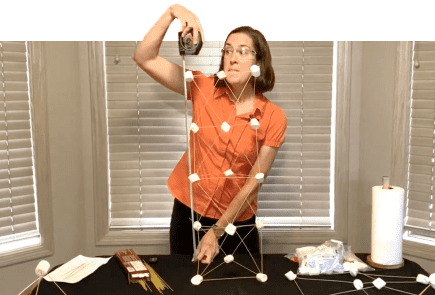What can a rubber band and a cotton ball teach you about potential and kinetic energy? Join Michael Lewandowski to make your own cotton-ball launcher and find out!
Background
When you stretch a rubber band it stores elastic potential energy—the energy stored inside a material when it is stretched, squished, bent or twisted. This is different from gravitational potential energy, which is stored in an object that is lifted off the ground. Both types of potential energy can be converted to kinetic—the energy of motion. All moving objects have kinetic energy, but motionless ones have none. When energy is converted between forms the total amount of energy remains the same. In other words, it is conserved. (Some energy, however, may also be converted to heat due to friction—but that is still a form of energy.)
Key Concepts
- Physics
- Potential energy
- Kinetic energy
- Conservation of energy
Materials
- An adult helper
- Short pencil or Popsicle stick
- Two thin rubber bands
- Two empty toilet paper tube or one empty paper towel tube cut in half
- Packing tape or other strong tape
- Scissors
- Cotton balls
- Yardstick
- Ruler
- Three pieces of paper
- Partner
- Single-hole puncher (optional)
Preparation
- Gather your materials in a clear, open area.
- Use your yardstick to measure out a distance of three yards using a piece of paper to mark each yard. Place your yardstick in the first yard. This will be your launching station. How far do you think you will be able to launch your cotton balls?
- Use your scissors to carefully cut one of the toilet paper tubes in half lengthwise.
- Squeeze the roll so it becomes narrower (about half the original diameter) then tape it to hold it in place.
- Use your scissors or your hole puncher to make two holes in the skinny tube. (If you’re using a popsicle stick, use scissors to make narrower holes the same shape as the popsicle stick.) Make the holes opposite each other, half an inch away from the end, so you can poke your pencil or popsicle stick all the way through the tube.
- Carefully push your pencil or popsicle stick through the holes.
- On your second toilet paper tube cut two slits into one end of the tube about one quarter inch long and one-half inch apart.
- Cut two more slits on the same end of the tube directly across from the first two.
- Carefully loop one rubber band through the slits on one side so that it hangs from the cardboard piece in the middle. Put a piece of tape over the slits to reinforce the cardboard tab.
- Loop the other rubber band through the slits on the other side of the tube. When you are finished the tube should have a rubber band hanging from each side.
- Holding the rubber-band tube so its rubber bands are at the top, slide the narrower tube into the wider one with the pencil end at the bottom.
- Carefully loop each rubber band end around the pencil.
- Hold your launcher so that the pencil is at the bottom. Place a cotton ball on the top so that it rests inside on the narrower tube.
- Go to your launching station and stand next to the zero-end of the yardstick. Now that you have built your launcher, how far do you think your cotton ball will fly?
- Hold your launcher slightly horizontally (without dropping the cotton ball). Have your partner hold the ruler next to your launcher.
- Pull back on the pencil so the inner tube extends two inches out the back of the launcher. Carefully aim your cotton ball (away from people).
- Release the pencil and watch your cotton ball fly!
- Use your yardstick to measure the distance the cotton ball traveled.
- Repeat the previous steps, each time pulling the launcher back one inch farther. When did the cotton ball the travel the shortest distance? When did it travel the farthest?
- Extra: Try testing different rubber-band thicknesses and see which launch the farthest!
Observation and Results
In this activity you used two types of energy to load and launch your cotton ball. As you drew back on the pencil with the cotton ball loaded you were adding potential energy to the system. The farther you pulled back on the pencil, the more potential energy was being stored. When you released the pencil, the energy became kinetic and the cotton ball should have gone flying through the air!
The farther you pulled back on your launcher the more potential energy you added to the system—and the more you stored the more kinetic energy should have been released when you shot the cotton ball. As a result, the farther you pulled back on the launcher, the farther the cotton ball should have traveled.
Safety First and Adult Supervision
- Follow the experiment’s instructions carefully.
- A responsible adult should assist with each experiment.
- While science experiments at home are exciting ways to learn about science hands-on, please note that some may require participants to take extra safety precautions and/or make a mess.
- Adults should handle or assist with potentially harmful materials or sharp objects.
- Adult should review each experiment and determine what the appropriate age is for the student’s participation in each activity before conducting any experiment.
Next Generation Science Standard (NGSS) Supported - Disciplinary Core Ideas
This experiment was selected for Science at Home because it teaches NGSS Disciplinary Core Ideas, which have broad importance within or across multiple science or engineering disciplines.
Learn more about how this experiment is based in NGSS Disciplinary Core Ideas.
Engineering Design (ETS)1: Engineering Design
Grades 3-5
- 4-PS3-1. The faster a given object is moving, the more energy it possesses.
- 4-PS3-2,3. Energy can be moved from place to place by moving objects or through sound, light, or electric currents.
Grades 6-8
- MS-PS3-1. Motion energy is properly called kinetic energy; it is proportional to the mass of the moving object and grows with the square of its speed.
- MS-PS3-2. A system of objects may also contain stored (potential) energy, depending on their relative positions.
Grades 9-12
- HS-PS3-1. Energy is a quantitative property of a system that depends on the motion and interactions of matter and radiation within that system.
- HS-PS3-2. There is a single quantity called energy due to the fact that a system’s total energy is conserved, even as, within the system, energy is continually transferred from one object to another and between its various possible forms.
- HS-PS3-3. At the macroscopic scale, energy manifests itself in multiple ways, such as in motion, sound, lights, and thermal energy.
Grades 3-5
- 4-PS3-2. Energy is present whenever there are moving object.
- 4-PS3-3. When objects collide, energy can be transferred from one object to another thereby changing their motion.
Grades 6-8
- MS-PS3-5. When the motion energy of an object changes, there is inevitably some other change in energy at the same time.
Explore Additional Science at Home Videos and Activities

Inflation Station
Follow along with 3M’s Chief Science Advocate, Jayshree Seth, as she teaches students how chemistry can help put some air where it’s most needed!

Marshmallow Tower
Have you ever wondered how skyscrapers can be so tall?
Or how people build bridges to span long distances? Explore engineering techniques to build sturdy structures using only marshmallows and uncooked spaghetti.

C02 Balloon
Baking soda and acid reactions in baking make things puff and rise.
But how could you use this same chemical reaction to blow up a balloon?

